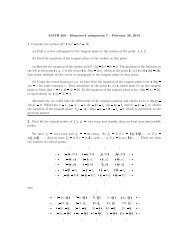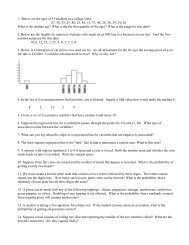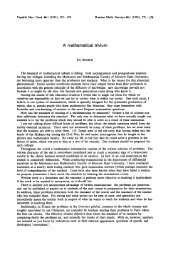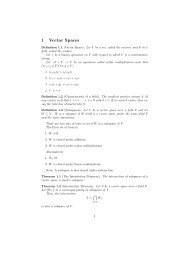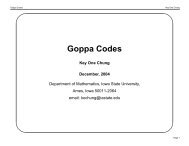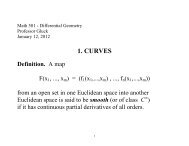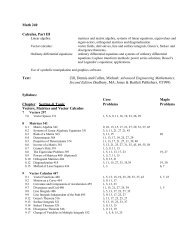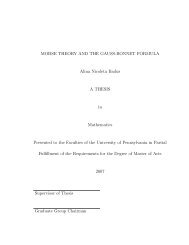Barcodes - Department of Mathematics
Barcodes - Department of Mathematics
Barcodes - Department of Mathematics
You also want an ePaper? Increase the reach of your titles
YUMPU automatically turns print PDFs into web optimized ePapers that Google loves.
2 ROBERT GHRIST<br />
This review will introduce these themes and survey an example <strong>of</strong> these techniques<br />
applied to a high-dimensional data set derived from natural images.<br />
1.2. Clouds <strong>of</strong> data. Very <strong>of</strong>ten, data is represented as an unordered sequence <strong>of</strong><br />
points in a Euclidean n-dimensional space E n . Data coming from an array <strong>of</strong> sensor<br />
readings in an engineering testbed, from questionnaire responses in a psychology<br />
experiment, or from population sizes in a complex ecosystem all reside in a space<br />
<strong>of</strong> potentially high dimension. The global ‘shape’ <strong>of</strong> the data may <strong>of</strong>ten provide<br />
important information about the underlying phenomena which the data represents.<br />
One type <strong>of</strong> data set for which global features are present and significant is the<br />
so-called point cloud data coming from physical objects in 3-d. Touch probes,<br />
point lasers, or line lasers sweep a suspended body and sample the surface, recording<br />
coordinates <strong>of</strong> anchor points on the surface <strong>of</strong> the body. The cloud <strong>of</strong> such<br />
points can be quickly obtained and used in a computer representation <strong>of</strong> the object.<br />
A temporal version <strong>of</strong> this situation is to be found in motion-capture data,<br />
where geometric points are recorded as time series. In both <strong>of</strong> these settings, it is<br />
important to identify and recognize global features: where is the index finger, the<br />
keyhole, the fracture?<br />
Figure 1. Determining the global structure <strong>of</strong> a noisy point cloud<br />
is not difficult when the points are in E 2 , but for clouds in higher<br />
dimensions, a planar projection is not always easy to decipher.<br />
Following common usage, we denote by point cloud data any collection <strong>of</strong> points<br />
in E n , though the connotation is that <strong>of</strong> a (perhaps noisy) sample <strong>of</strong> points on a<br />
lower-dimensional subset. For point clouds residing in a low-dimensional ambient<br />
space, there are numerous approaches for inferring features based on planar projections:<br />
reconstruction techniques in the computer graphics and statistics literatures



